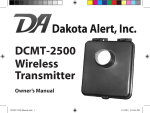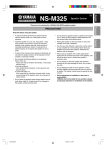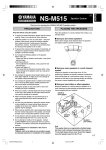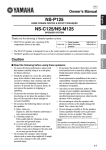Download Dakota Alert WMT-3000 User's Manual
Transcript
WMT-3000
Wireless
Transmitter
Owner’s Manual
Warnings
This device complies with Part 15 of the FCC rules, Operation of this device is subject to the following conditions: 1. This device may not cause harmful interference. 2. This device must accept
any interference, including interference that may cause undesired operation.
Installation:
The WMT-3000 transmitter is used with the Dakota Alert WR-3000 receiver. The WMT-3000 transmitter uses a passive infrared (PIR) detector to detect people, vehicles or large animals at the
monitored location. When the transmitter detects an object, it will send a signal to the receiver,
which will sound one of four different tones (Classical, Westminster Chime, Ding Dong, or Whistle) for a few seconds. The transmitter can be used as a driveway alarm, or in the back yard to
monitor around tool sheds or patios.
Operation: (Always test unit prior to installation)
1. Connect a 9-volt alkaline battery to the transmitter.
2. For maximum range between the transmitter and receiver, the transmitter should be mounted on a wooden post or tree (steel posts may cause interference with the radio signal). Although
the maximum range is about 600 feet, obstructions such as hills, trees, metal siding and stucco
can reduce the range.
2.
PIR settings (figure 1)
The jumpers settings are as follows:
Range: LED:
Filter:
Reset:
High-80 feet
Medium- 50 feet
Low- 30 feet
ON- led will flash when it detects
OFF- led is always dark
On- set for outdoor use
Off-set for indoor use
15 seconds to reset after activation
120 seconds to reset after activation
Coding the transmitter:
Note: The transmitters and receivers are preset
at the factory. DO NOT change settings, unless
changing the tune or experiencing false signals.
1. When looking at the PIR you will see clips on the
sides of the plastic case. Push one of the clips away
from the center of the case and lift out the PIR and
the plastic backing. You will now be looking inside of
the case at the radio transmitter (figure 2)
Figure 1
PIR with cover removed
3.
2. Locate the dip switches in the WMT-3000 transmitter module (figure 2).
3. The first eight dip switches are for the frequency setting (256 combinations).
Set switches 1-8 (3) to match the eight switches in the receiver.
4. Switches 9 and 10 (4) are for the zone/channel settings on the transmitter.
The four zones are listed in the table below.
Switch
10
Channel
12-volt
DC output
Tune
On
On
1
Yes
Classical
4.
Off
On
2
No
Westminster
On
Off
3
No
Ding Dong
Off
Off
4
No
Whistle
{
Switch
9
{
LOW BATTERY ALERT: If the receiver sounds a second alert 30 seconds after the first alert, provided
nothing trips the transmitter again, the 9-volt battery in the transmitter should be changed.
3
4
figure 2
Mounting the transmitter:
1. Select a location to mount the transmitter, such as a post or tree.
2. For best results, the transmitter should
be about three to four feet off the ground,
and about twenty feet from the side of the
drive.
3. The transmitter will detect people or vehicles to about eighty feet, but occasionally
it may detect one hundred feet. For this reason, it is best to avoid pointing the transmitter at streets or roads in the distance.
4. The transmitter must remain completely
immobile or a false signal may result. For
this reason, avoid mounting the transmitter on flimsy objects or small diameter trees
that may move in the wind
figure 3
5.
Coding the receiver:
1. Open the receiver case by inserting a small screwdriver into one of the pry notches on
the side of the case. (refer to receiver manual)
2. Gently lift off the front cover.
3. Locate the eight dip switches on the receiver and make sure they are set identically
to dip switches 1-8 on the transmitter.
Note: If more than one transmitter is used with the receiver, the first eight dip switches
of all transmitters must match the eight dip switches of the receiver.
Note: Whenever a change is made to the time jumper or the dip switches, the receiver
must be turned OFF and then back ON to operate properly.
Frequency: 433.92 MHz
Operating range: -30˚F to 110˚F
Battery life: 6-12 months
6.
Troubleshooting the WMT-3000
Although the WMT-3000 should be very reliable, there are occasions when you might have
false alarms or a failure to alert. If you are getting false alarms, please try this:
• Set filter jumper to “ON”.
• Decrease range jumper.
• Make sure that the transmitter is not pointing at a road in the distance.
• The sun may be causing false signals; try to relocate the transmitter to a different position.
• Make sure the transmitter is not detecting animals.
If the transmitter is not detecting, try one of these:
• Change the battery in the transmitter.
• Make sure the transmitter and receiver are coded alike.
• Change the height and distance of the transmitter from the driveway.
• Move the transmitter closer to the receiver.
• Keep the transmitter away from large metal objects that may interfere with the radio signal.
TECHNICAL SUPPORT
If you encounter any difficulty in the operation of this product after reading the manual,
please contact us. You can reach us by phone at 605-356-2772 from 8:30 AM to 5:00 PM
Monday through Friday (Central Standard Time). We will be happy to answer your questions
and help you in any way we can.
7.
WARRANTY
Dakota Alert warrants this product to be free of defects in material and workmanship for a
period of one year from the date of purchase. This warranty does not cover damage resulting
from accident, abuse, act of God or improper operation.
If this product does become defective, simply return it to Dakota Alert. Please include a note
describing the troubles along with your name and return address as well as the original sales
receipt. If the product is covered under warranty it will be repaired or replaced at no charge. If
it is not covered by warranty, you will be notified of any charges before work is done.
Dakota Alert, Inc.
32556 E. Main Street
P0 Box 130
Elk Point, SD 57025
Phone: (605) 356-2772
Fax: (605) 356-3662
Web: www.dakotaalert.com
8.















